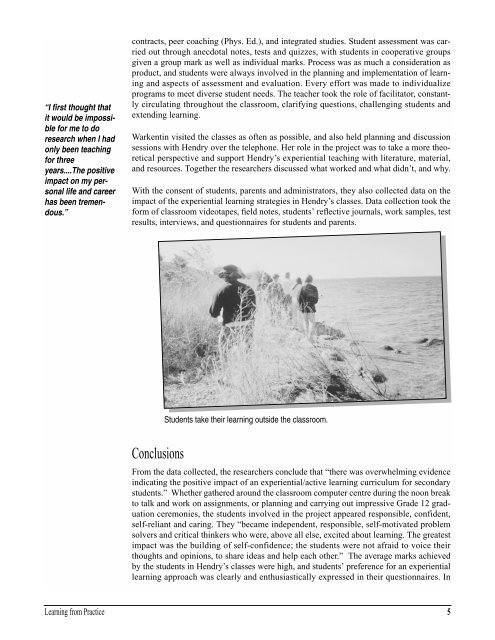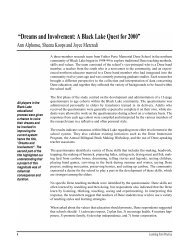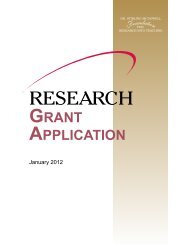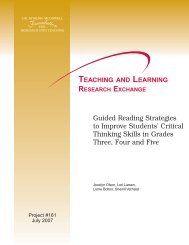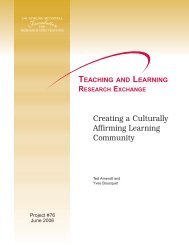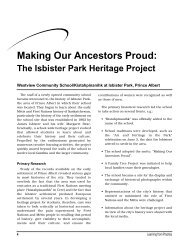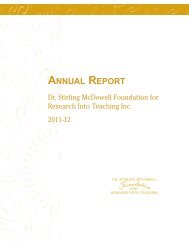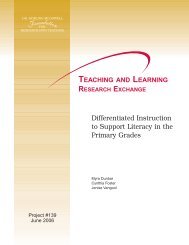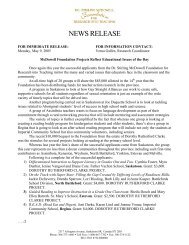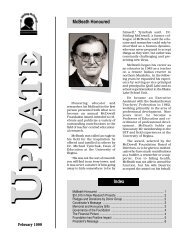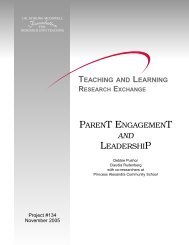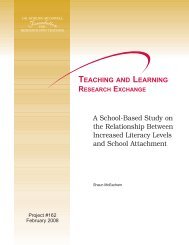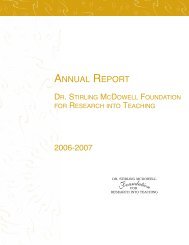Research Bulletin, Vol. 1, No. 2, 1996 - Dr. Stirling McDowell ...
Research Bulletin, Vol. 1, No. 2, 1996 - Dr. Stirling McDowell ...
Research Bulletin, Vol. 1, No. 2, 1996 - Dr. Stirling McDowell ...
You also want an ePaper? Increase the reach of your titles
YUMPU automatically turns print PDFs into web optimized ePapers that Google loves.
“I first thought thatit would be impossiblefor me to doresearch when I hadonly been teachingfor threeyears....The positiveimpact on my personallife and careerhas been tremendous.”contracts, peer coaching (Phys. Ed.), and integrated studies. Student assessment was carriedout through anecdotal notes, tests and quizzes, with students in cooperative groupsgiven a group mark as well as individual marks. Process was as much a consideration asproduct, and students were always involved in the planning and implementation of learningand aspects of assessment and evaluation. Every effort was made to individualizeprograms to meet diverse student needs. The teacher took the role of facilitator, constantlycirculating throughout the classroom, clarifying questions, challenging students andextending learning.Warkentin visited the classes as often as possible, and also held planning and discussionsessions with Hendry over the telephone. Her role in the project was to take a more theoreticalperspective and support Hendry’s experiential teaching with literature, material,and resources. Together the researchers discussed what worked and what didn’t, and why.With the consent of students, parents and administrators, they also collected data on theimpact of the experiential learning strategies in Hendry’s classes. Data collection took theform of classroom videotapes, field notes, students’ reflective journals, work samples, testresults, interviews, and questionnaires for students and parents.Students take their learning outside the classroom.ConclusionsFrom the data collected, the researchers conclude that “there was overwhelming evidenceindicating the positive impact of an experiential/active learning curriculum for secondarystudents.” Whether gathered around the classroom computer centre during the noon breakto talk and work on assignments, or planning and carrying out impressive Grade 12 graduationceremonies, the students involved in the project appeared responsible, confident,self-reliant and caring. They “became independent, responsible, self-motivated problemsolvers and critical thinkers who were, above all else, excited about learning. The greatestimpact was the building of self-confidence; the students were not afraid to voice theirthoughts and opinions, to share ideas and help each other.” The average marks achievedby the students in Hendry’s classes were high, and students’ preference for an experientiallearning approach was clearly and enthusiastically expressed in their questionnaires. InLearning from Practice 5


